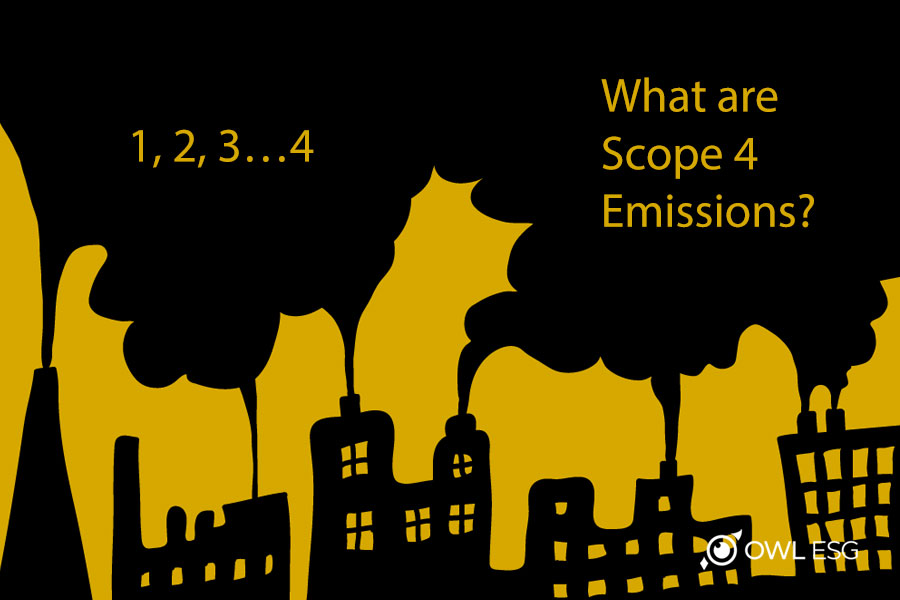We know that people who smoke cigarettes can greatly improve their health—now and into the future—by cutting back or quitting altogether. And, when people make a pledge to stop smoking it’s easy to track their progress by counting how many cigarettes they smoke per day, over time.
Of course, while cutting back is great, it would be even better to avoid smoking in the first place. Here, we apply this line of reasoning to reducing carbon emissions (technically carbon dioxide, CO2), or more generally, greenhouse gas (GHG) emissions—CO2, methane, and nitrous oxide—versus avoiding them altogether. This leads us into the realm of Scope 4 or “avoided” emissions.
How to measure progress on emissions?
The environmental fallout of a hotter planet is having noticeable financial impacts in many sectors of the economy—premiums for property insurance are rising (some insurers are pulling out of certain areas altogether, as they cannot raise premiums enough to cover their risks), crops are being wiped out by floods and drought, tourist destinations are limiting hours due to extreme heat, and more.
All of this is highlighting the urgency of reducing greenhouse gases that trap heat in the earth’s atmosphere. But if we think of a pledge to reduce GHG emissions like an individual’s promise to cut back on smoking, we quickly realize we need a way to measure emissions reductions that would be the equivalent of counting the number of cigarettes smoked.
The Paris Agreement of 2015 is a legally binding treaty to limit global warming to well below 2.0 degrees Celsius (preferably 1.5 degrees), above pre-industrial levels. It’s one thing to commit to that goal, but how do we measure reductions? Beginning in 2024, countries will have to meet transparency standards on actions taken and progress toward “climate change mitigation, adaptation measures and support provided or received.” In other words, the way we measure reductions in emissions is going to be scrutinized more going forward than it has been to date.
Most large companies are now reporting on their progress with respect to reducing emissions using categories defined in the Greenhouse Gas (GHG) Protocol developed by the World Resources Institute. These corporate disclosures focus primarily on what are known as Scope 1 and Scope 2 emissions, and to a much lesser extent Scope 3. The concept of Scope 4 emissions, or finding ways to avoid emissions altogether, has received little attention. We think that should change.
What are Scope 1, 2, and 3 emissions?

Before we get into what Scope 4 emissions covers, we briefly review definitions for the more familiar Scopes 1, 2, and 3:
Scope 1 – Direct Emissions: GHG emissions directly emitted by sources the reporting company owns and controls. Includes using fossil fuels onsite to generate heat and/or electricity, and fuel used by airlines and other businesses in the transportation sector.
Scope 2 – Indirect Emissions: GHG emissions generated as a result of the use of purchased electricity, steam, heat, or cooling that a company uses to conduct its activities. This could be running a factory, data center, hotel, farm, or bank—any type of business of any size. It also applies to governments in providing services to their citizens.
Scope 3 – Indirect Emissions: GHG emissions that result from activities and assets not owned or controlled by a business, but that it indirectly affects within its value chain. In simpler terms, Scope 3 emissions include the GHGs a company’s suppliers generate as a result of making and delivering materials to the company, and emissions its customers generate as a result of using its products and services. Scope 3 is more difficult to measure/estimate than Scope 1 and 2, and often represent well over half (as much as 70% or more) of a typical company’s total emissions.
What About Scope 4?
Getting back to the metaphor that it’s better to avoid smoking in the first place than to reduce the number of cigarettes smoked per day, we now turn to Scope 4 emissions. Also known as “avoided emissions,” the term was coined back in 2013 in the GHG Protocol. Avoided emissions are defined as reductions in emissions that occur “outside of a product’s lifecycle or value chain, but as a result of the use of the product.” Huh? Let’s try again. Think of Scope 4 as emissions that are averted by using a product or service.
Still not clear? Let’s look at an example.
Company X makes air conditioning units. It generates Scope 2 emissions by manufacturing those units, and its Scope 3 emissions are high because its A/C units consume a lot of electricity. According to the World Economic Forum, heating and cooling technology for buildings create roughly 15 percent of global carbon emissions.The U.S. National Renewable Energy Laboratory (NREL) estimates that air conditioning is responsible for roughly 4.0 percent of total global greenhouse gas emissions annually.
Why is A/C such a big problem? As the old saying goes, “it’s not the heat, it’s the humidity.” Climate change is affecting both ambient temperatures and humidity—in other words, it’s getting both warmer and more humid. And, according to scientists from NREL and Xerox PARC, the increase in global humidity will have a bigger impact on emissions than the increase in global temperatures.
Air conditioning units rely on harmful refrigerants to deal with humidity. Some improvements to reduce the emissions associated with this technology have been made (those fall under Scope 3), but we are reaching the physical limits of those improvements. That means there won’t be many ways to further reduce the emissions today’s A/C units generate. And with temperatures above 100 degrees Fahrenheit becoming commonplace in a growing number of cities, more people will be running their A/C for longer. That, of course, generates more GHGs, which heats the planet more, which increases the demand for A/C, which… well, you get the picture.
What does all of this have to do with Scope 4 emissions?
What if, instead of today’s A/C units that create so many harmful emissions, we had something better? According to NREL, innovators are developing new ways for air conditioning to control humidity that could be up to 10 times more efficient than today’s technology. NREL states that even a technology that is “only” five times more efficient would avoid 40 percent of cooling-energy emissions that would otherwise occur in 2050, based on projections for populations, gross domestic product, air conditioner ownership per capita, the carbon intensity of power grids, and hourly weather for every part of the world. That’s avoiding emissions.
Another frequently cited example in Scope 4 discussions is something you may already use: laundry detergent that works well in cold water. Washing in cold water prevents emissions that would otherwise occur because we’re not heating water! These avoided emissions would not be counted in Scope 1, Scope 2, or even Scope 3 emissions reductions. These two examples show that avoided emissions are often associated with innovations that bring in new revenues because they are outside of the lifecycle assessment of carbon emissions from existing products.
Measuring what didn’t happen – Attributional vs. Consequential
Companies are not currently required to report Scope 4 emissions. Although we believe that drawing attention to the potential impact of Scope 4 is important, there are no universally accepted standards for measuring them. The debate about the best approach to doing so centers on two contenders. In one corner, we have the “Attributional” method and in the other corner, the “Consequential” method.
According to the World Resources Institute:
- The Attributional method compares the total lifecycle GHG emissions of a company’s product to those of an alternative product that provides an equivalent function.
- The Consequential approach estimates the sum of all (which could be the entire planet) system-widechanges in emissions or removals that occur because of the product.
So, a product that reduces emissions compared to another substitute product might look good through an Attributional lens, even if it causes emissions to increase in some other way, perhaps by forcing people to travel longer distances or use textiles that have a high carbon footprint. The Consequential approach takes all of the positives and negatives into consideration.
Most companies that report on avoided emissions use the Attributional approach and (surprise) focus on positive impacts, despite the fact that negative impacts are equally common. Emitwise says while the WRI and GHG protocol recommend the Consequential approach, few companies currently use it due to insufficient data and know-how that would be required.
We expect to hear more about Scope 4 going forward and to see more data that will help to identify companies that are developing new products and services that avoid emissions. To learn more about how OWL can help with your ESG analyses, contact us.




